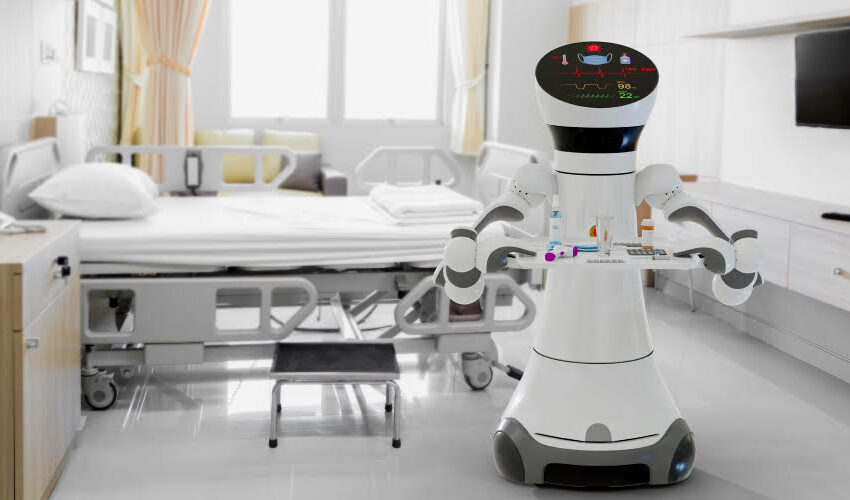Experiencing the COVID-19 pandemic these past few years have left many wondering about the future of medicine. We are here to explain that the future of patient support, hygienic practices, and surgery – to name a few – lies within the power of robotics. We will be revisiting the history of medical robots, learning about the use of robots during COVID-19, and looking ahead to see how robotics will continue to positively transform the medical field in the next decade.
How did the use of medical robots begin?
Robots have been around since the mid-20th century, but medical robots really made their first appearance in the 1980’s. Yes, the same decade that gave us Robocop, Short Circuit, and even the Terminator, also gave us actual, real-life robots. But instead of stopping crime, escaping military facilities, or causing pure havoc on the human race, these medical robots created a new possibility of healing and supporting patients like never before.
Specifically, the Programmable Universal Machine for Assembly, also known as PUMA, was the first medical robot used in surgery in 1985. This robotic surgical arm truly paved the way for the fields of medicine and robotics to come together to offer safer, faster, and more precise medical services, like surgery, for patients. Similarly, ROBODOC, was the first robot to assist in a total hip arthroplasty (THA) in 1992, which made waves in the medical field. Since PUMA and ROBODOC, robots have been used to assist in surgical settings, notably in brain, laparoscopic, gynecologic, and prostate surgeries.
Robots and COVID-19
The COVID-19 pandemic magnified the importance of hygienic practices for all. We were urged to wash our hands for at least 20 seconds, wipe everything down with disinfectant wipes, and apply hand sanitizer often! We were also advised to keep distance from others- something robots made possible for hospital units during the height of COVID-19. Below are four examples of hygiene robots, a subset of medical robots, that forever changed the way medical facilities, and other public spaces, handle highly transmissible illnesses.
- UVD Robots
Once the COVID-19 pandemic was in full force, many major medical facilities began using Ultraviolet Disinfection (UVD) Robots complementarily to prevent the spread of the virus, and to protect hospital staff during the contagion. UVD robots work autonomously, meaning they are programmed to stroll through hospital corridors and rooms and disinfect spaces using Ultraviolet radiation. Many of these robots are programmed purposefully to support human medical staff, immediately shutting down when they sense humans around in order to protect them from direct contact with Ultraviolet radiation. Think about how many hospital rooms had to be quickly disinfected in order to host the next patient during COVID-19, UVD robots made it possible to do this faster and more reliably.
2. XDBOT
Along with needing to disinfect medical facilities, high-touch public spaces like airports, hotels, and dining areas needed precise cleaning during this pandemic. Researchers at Nanyang Technological University (NTU) deployed a new robot, eXtreme Disinfection roBOT (XDBOT) to tackle the disinfection of hard-to-reach spaces in public areas. Unlike UVD robots, the XDBOT is semi-autonomous, meaning that it is controlled remotely by a human, up to 98.4 feet away! What has made XDBOT incredibly useful during COVID-19 is its electrostatic-charged nozzle, which allows for the disinfectant spray to reach behind surfaces, unlike a regular pressure-spray nozzle, for example.
The XDBOT offers the same invaluable support that UVD robots do- eliminating dangerous, time-consuming, and exhausting work from human workers’ daily tasks. Chen I-Ming, professor and project leader of XDBOT, quickly noticed that custodial workers’ services were in high demand during the height of COVID-19; as a result, he led the creation of this robot. Here in the US, we saw schools ask parents to step in with janitorial duties and even hire students to do custodial work because there were not enough workers to disinfect spaces with the speed, precision, and frequency needed to combat this deadly virus. Robots like XDBOT pose a feasible solution to real-time challenges that affect service workers during health crises.
3. Temi
Another semi-autonomous robot, Temi, has been instrumental in decreasing the viral transmission between doctors and patients. Temi is a personal-assistant robot with the ability to communicate with users via Amazon’s Alexa. During COVID-19, Temi took patients’ temperatures, and delivered food and medication to patients in need. Temi also serves as a remote instrument for doctors to tele consult their patients in the present. Similar to UVD robots, a Temi robot can be programmed to map out the route where it needs to travel to in order to serve its purpose.
Additionally, Temi combines the efficiency of standard medical robots, with the care and humanness that a real-time connection with a doctor provides. As a patient, you would be able to get your temperature taken by the actual Temi robot while video-chatting your physician via Temi’s screen, all at the same time, all from a safe, remote distance.
4. Ref-1
During the COVID-19 pandemic, food delivery services were highly requested and absolutely desirable for many individuals who did not want to risk being infected by eating at, or going into a restaurant for their favorite meal. Food delivery apps like Grubhub, Uber Eats, and DoorDash remedied that concern for customers who wanted restaurant food from the safety of their homes; but, the danger still existed for the delivery drivers providing that very service.
Autonomous Service Delivery robots, like Ref-1, also known by Rev-1, offer solutions for all the challenges posed by the high-demand in food delivery services during COVID-19. Ref-1 also supports the ability to deliver medications to the homes of patients, a safe and resourceful way of providing patient care during a global pandemic. The Ref-1 robot is well-programmed to navigate busy city streets, a major plus for big cities who were largely impacted by the pandemic.
The future of Medical Robots
If at any point while reading this post, you felt concerned that robots will be taking over surgeons’, nurses’, doctors’, etc. jobs, let us assure you that we are not worried by this; in fact, many experts in robotics are excited about the reality that robots can support and serve medical professionals to provide the best quality of care for patients. In a podcast about robots in the world of medicine, Corey Ryan, director of medical robotics at KUKA Robotics, consoles listeners by naming that he doesn’t believe that robots will replace medical professionals. Ryan explains that ultrasound technicians, for example, have high-rates of developing carpal tunnel syndrome after 10 years of service, leading them to retire sooner than they’d like. This is where medical robots come in- they can do the technical tasks that require fine motor abilities while the technician explains to the patient what they’re seeing on the ultrasound screen. This way, experienced and highly favored technicians can work longer without developing a painful ailment.
Plainly put, medical robots can be programmed to support many tasks that physically strain (like in the example above) and/or unnecessarily consume the time of medical professionals (e.g. walking back and forth delivering charts to different patient rooms, etc.) Deploying robots, like the ones we reviewed in the list above, can change the future of medicine by creating more intentional, practical, and safer work spaces for medical providers. Ever since COVID-19, medical robots have been implemented as aides to those who are helping heal the world during medical crises, and we will continue to see this become more normal in medical spaces in the near future.

